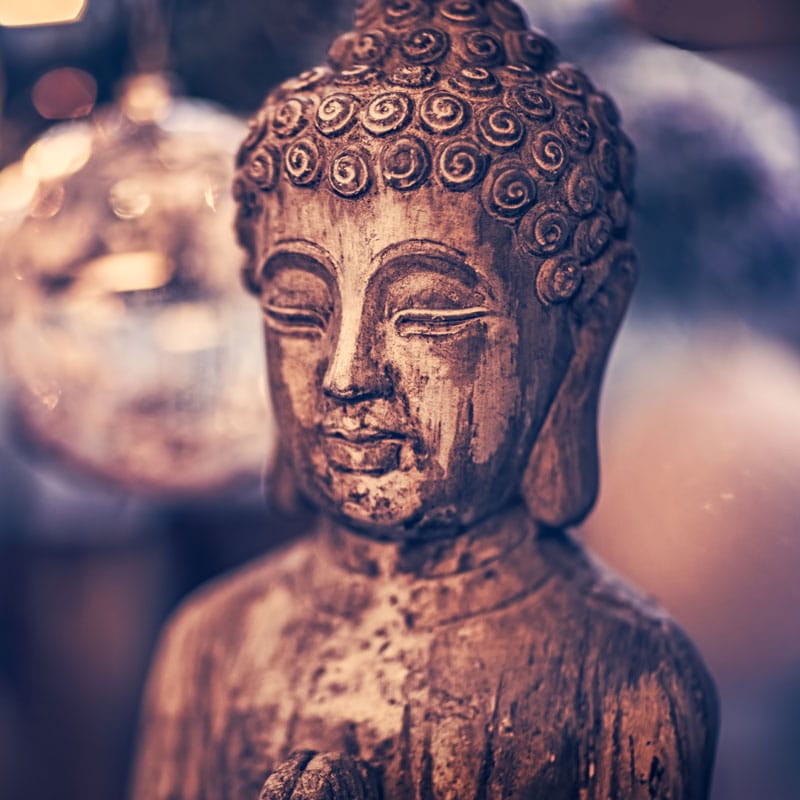Have you ever wondered whether you were using the words mindfulness or meditation correctly? It’s no surprise as there is a lot of confusion over the terms mindfulness and meditation, with some people using them interchangeably, and some people using the term mindfulness meditation. Because of this, one thing people often ask is: are mindfulness and meditation the same thing?
The quick answer
The quick answer is no. Meditation is a mind that is single-pointedly focused on one single thing and becomes familiar with it. Mindfulness (Sanskrit: smrti) is the mental process which bears that object in mind without forgetting it, along with introspection (Sanskrit: saṃprajanya), which keeps an eye on the body and mind for the occurrence of laxity and excitation. Without mindfulness remembering and holding your object, you have no meditation!

The long answer
To understand this fully, and why mistakes crop up in the modern day usage of the terms, one must explore the definitions and meanings behind them.
Mindfulness
There are multiple definitions of mindfulness out there, by various societies, universities and scholars, Buddhist and non-Buddhist. Here, we’re going to explore the main mindfulness definitions you’ve probably heard about.
In Buddhism
Mindfulness first and foremost has its origin in Buddhism, with the translation into English as “mindfulness” originating in the Pali term sati and in its Sanskrit counterpart smṛti. Smṛti originally means “to remember”, “to recollect”, “to bear in mind.”
Is mindfulness a good translation? The etymology and use of the English word mindfulness is revealing; ‘to be mindful’ means ‘to bear something in mind.’ A good example is the English phrase ‘mind your manners’ meaning be aware of, and to remember your manners. This shows mindfulness to be a pretty good translation of the Pali and Sanskrit word.

So what is mindfulness in Buddhism? To put it simply, mindfulness in Buddhism is a mental factor or process, whose function is to ascertain an object and bear it in mind, to remember it. When you are in meditation, it is with mindfulness that you ‘hold’ your object, e.g. the sensation of the breath at the nostrils. All meditation, therefore, requires the mental factor of mindfulness to stay on its object.

In the modern day mindfulness movement
The term mindfulness was picked up and embraced by Jon Kabat-Zinn when he formulated his Mindfulness-Based Stress Reduction (MBSR) programme, which has been so influential in the modern mindfulness movement in the West.
“the awareness that arises from paying attention, on purpose, in the present moment and non-judgmentally.”
Jon Kabat-Zinn
But, his definition seems to miss the boat on the original meaning, which he explicitly stated was based upon sati. Kabat-Zinn has defined mindfulness meditation as “the awareness that arises from paying attention, on purpose, in the present moment and non-judgmentally.” It has also been defined as “…a moment-to-moment awareness of one’s experience without judgment.”
Comparing the two
So, is Jon Kabat-Zinn’s ‘mindfulness’ and Buddhism’s ‘mindfulness’ the same thing? To put it bluntly, no! It would be incorrect to say that these newer definitions of mindfulness are wrong, but it is correct to say that they are not the same as mindfulness in Buddhism. Kabat-Zinn’s mindfulness is this ‘open moment-to-moment awareness,’ which does not even resemble the Buddhist mindfulness, simply a part of meditation, the part which bears your object in mind without forgetfulness. This is not to say that one is better than the other, only that they are different things entirely.
Meditation
Meditation is a mind that is single-pointedly focused on one single thing and becomes familiar with it. The Tibetan word for meditation, “gom” can be translated as familiarising, habituating. Thus, it means to familiarise with a positive state of mind, which actually refers to a training of the mind. There are two types, 1) fixed, also called stabilizing or placement meditation, and 2) analytic or insight meditation.
Meditation is not just for relaxing, rather it can be used to develop deep concentration (samadhi) and to access a state of mind which is the nature of clarity, calmness, bliss and a true sense of well-being. This blissful state is called “shamatha” in Sanskrit and this is the first type of meditation, fixed meditation. Once we have reached this very advanced concentrated state of mind, our mind is very serviceable, and though vipasyana or insight meditation, the second type, transforming our mind and developing deep wisdom and insight is quick and easy.
Whether we wish to experience some temporary peace and calm, or become a happier and more positive person by training to remove bad habits of mind and cultivate positive ones, or find deeper meaning by exploring the depths of our mind and discovering the true nature of reality, meditation can be practised by everyone!

Why meditate?
To develop the wish to meditate, and the motivation to practice, we first need to understand why we need to meditate. When we first try to meditate, we notice that our mind is all over the place. This experience shows us how little control we have over our mind. Having so little control over our mind is the reason why we experience negative feelings and are not able to be happy. Meditation is more than just a fun way to relax, it is essential if we want to experience our deepest wish which drives our day-to-day life – lasting happiness.
All positive feelings, such as happiness, joy, and love, just like all negative feelings such as sadness, worry, and anger – are experiences of mind. And because they are experiences of mind, their causes and remedies are not to be found outside the mind. If we want to be truly happy and free from painful feeling, we must learn how to control our mind. Meditation is the method to controlling the mind.



